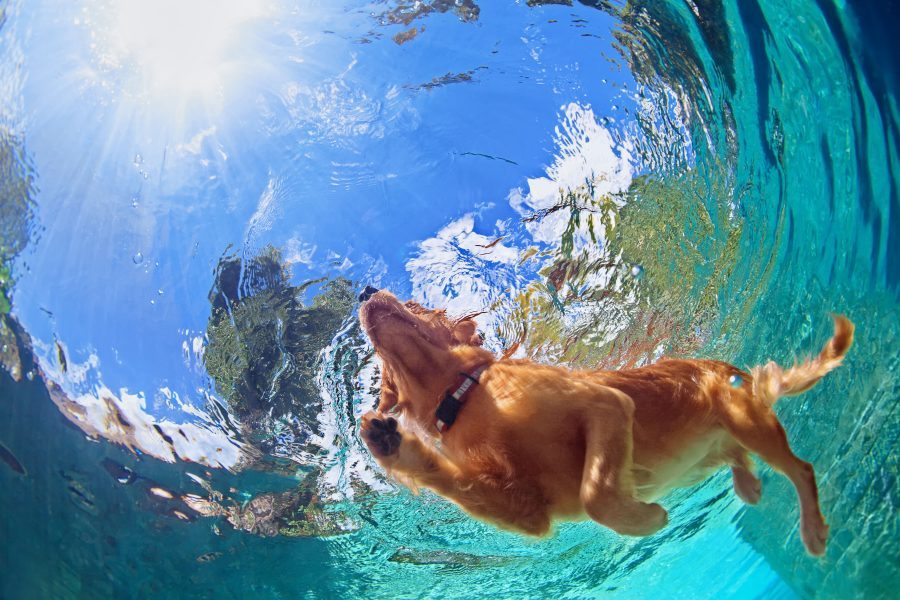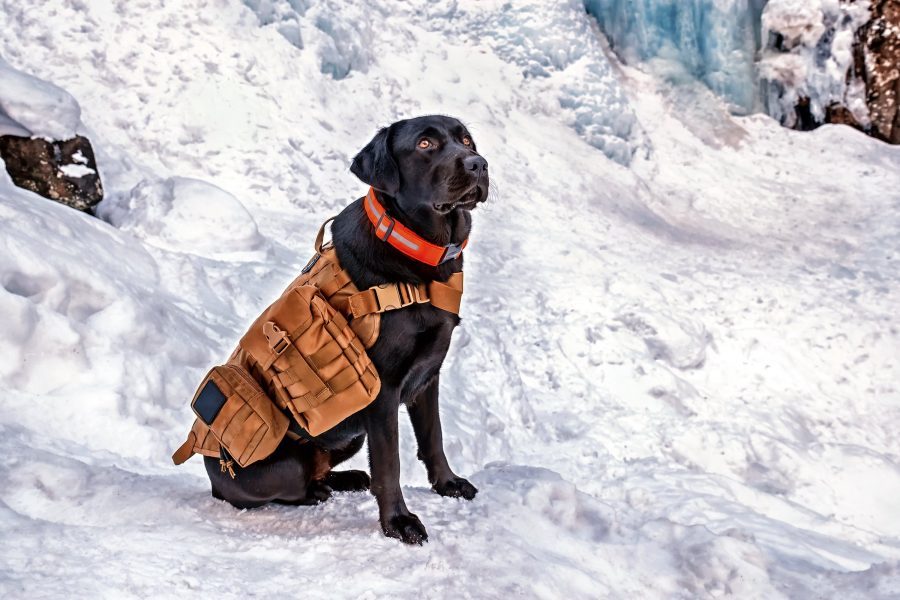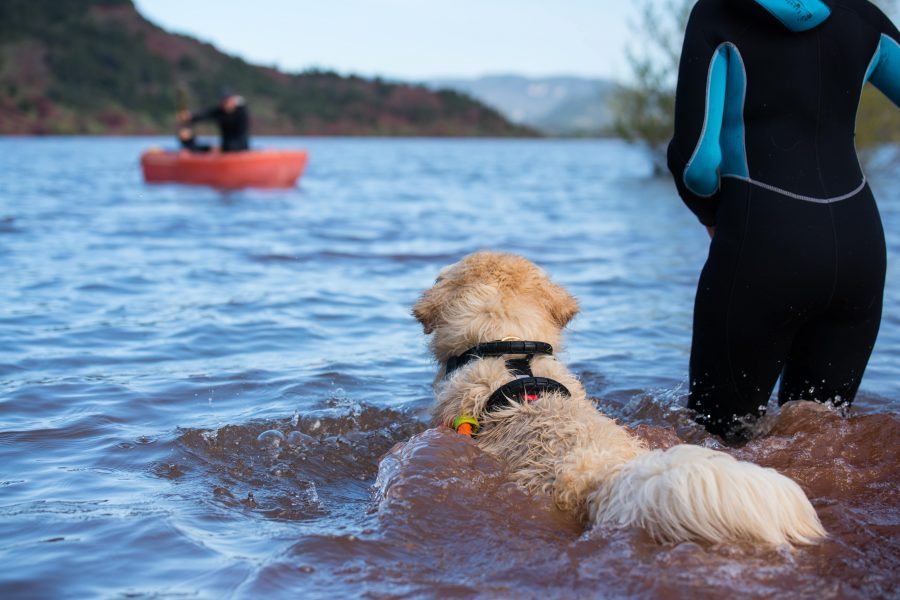When thinking about rescue dogs, the first images that comes to mind involve a Saint Bernard running in the snow or a Newfoundland Dog ready to dive into the water.
This is because it is known that some specific dog breeds are trained to save lives in some of the most danger situations.
Sea Rescue Dogs
Dogs that can dive into waterways, seas or lakes are trained for water rescue.
If your puppy likes to swim in the sea, that does not necessarily mean that he can become a sea rescue dog. Not all dogs, in fact, are suitable for this type of activity.

Our four-legged friends must have the following characteristics in order to perform a rescue:
- Suitable physical condition: in addition to weighing a minimum of 20 kg, they must be well-built, good at towing and capable of withstanding the fatigue of carrying a human body – as well as his weight;
- Thick hair: especially in colder regions, dogs are also chosen for their thick coat. Since the equipment is not always sufficient to protect them from the cold, breeds with a double layer of hair that can prevent water from reaching the skin are preferred;
- Passion for swimming: the disposition of dogs also play a big role. If they do not like to swim, they will have a very low chance of becoming rescue dogs.
Mountain Rescue Dogs
Thanks to their extraordinary intelligence and willpower, dogs are a fundamental ally of rescuers in case of emergency.
In the mountains, in fact, there are dog units formed by dogs and owners specialized in mountain rescue.
In order to join these units, the owners and the dogs must share a strong relationship based on trust and love, which is crucial to the success of missions in inaccessible places and in dangerous situations.
Avalanche rescue dogs are strongly determined and never get discouraged, since they are used to operating in the most complex climatic conditions, helping to find missing people at any cost.
During search missions, our four-legged friends play a vital role in case of accidents and avalanches.
They learn from the very beginning of their training not to react to distractions and that their goal is to find human beings.
This kind of attitude makes them a key component in the process of saving lives in different kind of circumstances.

The first prerequisite to perform this kind of activity is the sense of smell. Still ongoing scientific studies have found that dogs have an excellent ability to sniff man even hundreds of meters away.
Avalanche dogs, in particular, have a highly developed sense of smell, as they are able to find a human being under meters of snow.
Moreover, thanks to their agility, they are able to pass through wild and dangerous environments such as crevasses or places on a steep slope.
Best Rescue Dog Breeds
There are some breeds that are particularly suitable for rescue operations and therefore are highly preferred by trainers. Starting with sea rescue dogs, the most suitable breeds are:
- Newfoundland dog: it is certainly the water rescue breed par excellence, thanks to its extraordinary physical power. This breed has the ability of pulling more people at once and even a boat of several tons. These dogs have a very high resistance to fatigue and, above all, their insensitivity to cold makes them immediately ready for action (unlike divers who need to equip themselves);
- Landseer dog: this breed is very good at swimming, extraordinarily protective and, last but not least, has webbed feet which explain its swimming skills;
- Golden Retriever: in addition to their reputation as sweet and faithful puppies, these dogs are capable of learning the most diverse disciplines: water rescue, rubble searching and assisting people with disabilities.
When thinking about mountain rescue dogs, a Saint Bernard with a flask around his neck jumps immediately to mind. However, currently this breed has been joined by other breeds which are suitable for this activity. Let us find out together which are the most common avalanche rescue dogs:
- Saint Bernard: we must immediately dispel a myth. The iconic bottle around the neck is based on a 1820 painting by the English painter Sir Edwin Henry Landseer, who portrayed a specimen of this breed in this way. Fortunately, today almost everyone knows that it is not recommended at all to offer alcohol to people suffering from hypothermia. Alcohol is, in fact, a powerful vasodilator that favours the human body to lose heat. However, the extraordinary physical power of Saint Bernard is true. For hundreds of years this breed has been employed to transport milk and cheese, to trace tracks on fresh snow and to find mountaineers dispersed in the snow. Its great resistance to cold and high altitude makes it the best breed to have around in case of avalanche;
- Belgian Shepherd: these docile and versatile dogs are capable of carrying out the most diverse tasks. Usually employed as a watchdog and defensive animal, this breed is also very skilled in case of a catastrophe or avalanche. Belgian Shepherds are very watchful dogs and always ready for action;
- German Shepherd: this breed is very easy to train and it is no coincidence that it is employed by the Police, since dogs of this breed are very intelligent, faithful and skilled. The disposition of this breed makes it an ideal retriever dog, service dog, guard dog and police dog. Thanks to its highly developed sense of smell, it is exceptionally good at searching for missing people in the snow and in the event of earthquakes.
Rescue Dog Training
Dog training schools have developed different training methods. Although these may vary in different geographical areas, they anyway share many common elements.
First of all, the training of puppies must begin when they are 10 weeks old. When the puppies have developed physically and have reached the body structure of young adult dogs, they are made to train intensively for about a year and a half. After that, they can serve as rescue dogs for a period that could go from five to ten years, depending on the type of rescue they have to perform and the characteristics of the animal.
Trainers work in particular on:
- Obedience: since most of the times they work in dangerous places, this is the key element to assure the operation success and safety of the dogs themselves;
- Loyalty: the dog-man relationship is crucial in order to work well together. Rescuers and dogs must be a team and their relationship must be based on mutual loyalty and affection;
- Agility: whether they perform sea or mountain rescue, dogs must be strong and agile. Moreover, they must undergo constant training which ranges from the simplest exercises to the most advanced rescuing techniques;
- Sense of smell: dogs can be broadly classified as either air-scenting dogs or railing (and tracking) dogs. They can also be able to alert only a specific sent or they can follow any scent of a given type;
- Play: this element is very important for rescue dogs as well. Trainers make their puppies play simple games so that they can earn a prize (food). As time passes, dogs’ playtime consists in increasingly difficult and specialized tests.

There are two types of water training for sea rescue dogs. The first is for recreational purposes and involves water sports and sea games, while the second is operational training, focusing on rescue and exploration. The latter consists in a hard training for real rescue maneuvers.
The path to becoming a rescue dog is a long one and depends not only on the disposition of the dogs, but also on the owners. In order to make things work, there has to be a very strong dog-man bond, both during and outside working hours.
Rescue dogs have also their own equipment. They wear lifejackets with handles and floating harnesses, and are also equipped with reflectors in case of poor visibility.
Dog Rescue Courses
The training course for rescue dogs lasts at least one year. Water rescue dogs start with a training on land that includes courses of obedience and agility.
These lessons are aimed to teach dogs how to behave in crowded and chaotic environments such as beaches. In the first part of the course the bases are laid for building a deep dog-instructor bond.
During this period of time a common communicative code is defined, which allows dogs and owners to understand each other with just a few gestures or words.
The second part consists in a real training in water in order to improve swimming – a sport that dogs already know how to practice by nature – and to teach dogs how to rescue and transport people to the shore.
At the end of the training course, our four-legged friend obtains an official rescue certificate, which is recognized by the Coast Guard and the government as well. This gives the dogs the opportunity to work alongside the Civil Protection.
The training courses for mountain rescue dogs, like those for water rescue, include a period of training on land, which is however much more focused on the development of the sense of smell.
This is because the snow, in addition to muffling noises, almost completely eliminates odors. For this reason, the primary objective of the course is to make dogs develop an exceptional sense of smell.
This will make them capable of identifying people buried under thick layers of snow. Since the purpose of these missions is to find missing people, it is essential for the owners to be able to communicate perfectly with their rescue dogs.
There are two different schools for this: the first teaches the owners how to interpret the non-verbal language of dogs. The second requires special training, during which dogs learn to signal (by barking, running towards the trainer, touching him with their snout) that they have found the missing person.
